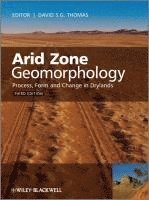
- Format
- Häftad (Paperback / softback)
- Språk
- Engelska
- Antal sidor
- 656
- Utgivningsdatum
- 2011-03-04
- Upplaga
- 3 ed
- Förlag
- John Wiley & Sons Inc
- Medarbetare
- Thomas, David S. G. (ed.)
- Illustrationer
- black & white illustrations, black & white tables, maps, figures
- Dimensioner
- 259 x 193 x 33 mm
- Vikt
- Antal komponenter
- 1
- ISBN
- 9780470519097
- 1362 g
Arid Zone Geomorphology
Process, Form and Change in Drylands
- Skickas från oss inom 5-8 vardagar.
- Fri frakt över 249 kr för privatkunder i Sverige.
Passar bra ihop
De som köpt den här boken har ofta också köpt Calculus av Robert A Adams (inbunden).
Köp båda 2 för 1824 krKundrecensioner
Fler böcker av David S G Thomas
-
The Dictionary of Physical Geography
David S G Thomas
This fully-revised comprehensive fourth edition covers the whole field of physical geography including climate and atmosphere, geomorphology, biogeography, hydrology, oceans, Quaternary, environmental change, soils, remote sensing and GIS. This ne...
-
Dictionary of Physical Geography
David S G Thomas
This fully-revised comprehensive fourth edition covers the whole field of physical geography including climate and atmosphere, geomorphology, biogeography, hydrology, oceans, Quaternary, environmental change, soils, remote sensing and GIS. This ne...
Recensioner i media
"I highly recommend the landmark and important book Arid Zone Geomorphology: Process, Form and Change in Drylands by David S. G. Thomas, to any students, specialists in the field, policy makers, business leaders, and anyone interested in this critical and fascinating field. This book will guide both students and professionals in many disciplines and professionals toward a deeper and richer understanding of the importance of arid regions, and the processes at work in these amazing areas of our planet." (Blog Business World, 27 October 2011)
Övrig information
David S. G. Thomas is a scientist and geographer. He was born in Buckland Hospital, Dover, Kent, UK, in 1958. He is professor of geography at the University of Oxford, and a professorial fellow of Hertford College, Oxford.
Innehållsförteckning
List of contributors. Preface to the first edition. Preface to the second edition. Preface to the third edition. I Large-scale controls and variability in drylands. 1 Arid environments: their nature and extent (David S.G. Thomas). 1.1 Geomorphology in arid environments. 1.2 Arid zone distinctiveness and the quest for explanation. 1.3 Arid zones: terminology and definitions. 1.4 The age of aridity on Earth. 1.5 The distribution of arid zones. 1.6 Causes of aridity. 1.7 Climate variability. 1.8 Dryland ecosystems. 1.9 Arid zone geomorphology and people. 1.10 Organisation of this book. 2 Tectonic frameworks (Helen Rendell). 2.1 Introduction. 2.2 Tectonic setting of drylands. 2.3 Uplift and erosion, subsidence and sedimentation. 2.4 Lengths of record. 2.5 Existing erosional and depositional records in arid environments. 2.6 Selected examples of the geomorphological impact of active tectonics in arid environments. 2.7 Conclusions. 3 Climatic frameworks: legacies from the past (David S.G. Thomas and Sallie L. Burrough). 3.1 Introduction. 3.2 The significance of arid zone fluctuations in the past. 3.3 Dating arid zone fluctuations. 3.4 Climatic interpretations and issues. 3.5 Conclusions. 4 Dryland system variability (David S. G. Thomas). 4.1 A framework for dryland diversity. 4.2 Geomonotony: how unvarying are the flat drylands of the world? 4.3 Within-dryland diversity. 4.4 Summary issues. 5 Extraterrestrial arid surface processes (Jonathan Clarke). 5.1 Introduction. 5.2 What does aridity mean beyond Earth? 5.3 Why should planetary scientists understand terrestrial arid geomorphology? 5.4 What can terrestrial geomorphologists learn from a solar system perspective? 5.5 Mars: water-based aridity. 5.6 Titan: methane-based aridity? 5.7 Venus: extreme aridity. 5.8 Future Directions. II Surface processes and characteristics. 6 Weathering systems (Heather A. Viles). 6.1 Introduction. 6.2 What makes arid environments unusual in terms of weathering systems? 6.3 Theoretical underpinnings of weathering systems research. 6.4 Current weathering study methods. 6.5 Linking processes to form in arid weathering systems. 6.6 Explaining the development of weathering landforms in arid environments. 6.7 Weathering rates in arid environments. 6.8 Arid weathering and landscape evolution. 6.9 Scale and arid weathering systems. 7 Desert soils (David L. Dunkerley). 7.1 Introduction: the nature and significance of desert soils. 7.2 Taxonomy of desert soils. 7.3 Some distinctive aspects of desert soil development. 7.4 Stone-mantled surfaces and desert pavements. 7.5 Inorganic seals at the soil surface. 7.6 Vesicular soil structures. 7.7 Conclusions. 8 Desert crusts and rock coatings (David J. Nash). 8.1 Introduction. 8.2 Sodium nitrate deposits. 8.3 Halite crusts. 8.4 Gypsum crusts. 8.5 Calcrete. 8.6 Silcrete. 8.7 Desert rock coatings. 8.8 Palaeoenvironmental significance of crusts. 9 Pavements and stone mantles (Julie E. Laity). 9.1 Introduction. 9.2 Surface types: hamadas and stony surfaces. 9.3 General theories concerning stony surface formation. 9.4 Stone pavement characteristics. 9.5 Processes of pavement formation. 9.6 Processes of clast size reduction in pavements. 9.7 Secondary characteristics of pavement surfaces and regional differences in pavement formation. 9.8 Secondary modifications to pavement surfaces. 9.9 Ecohydrology of pavement surfaces. 9.10 Relative and absolute dating of geomorphic surfaces based on pavement development. 9.11 Conclusions. 10 Slope systems (John Wainwright and Richard E. Brazier). 10.1 Introduction. 10.2 Badlands. 10.3 Rock slopes. 10.4 Conclusion. III The work of water. 11 Runoff generation, overland flow and erosion on hillslopes (John Wainwright and Louise J. Bracken). 11.1 Introduction. 11.2 Infiltration processes. 11.3 Fact
Du kanske gillar
-
Earth
Stephen Marshak
Häftad


